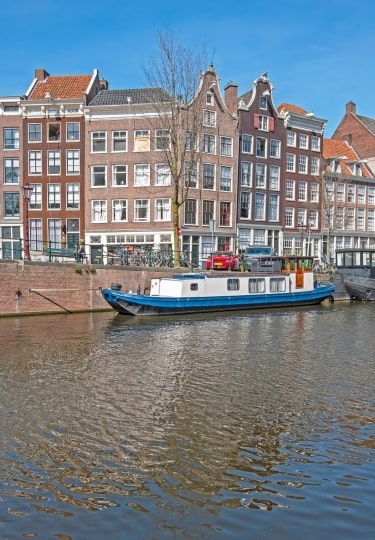Exploring the best things to do in Jordaan, Amsterdam unveils a world where 17th-century charm meets bohemian vibes, offering an array of experiences from historical insights to contemporary pleasures in one of the city’s most enchanting neighborhoods.
The area was once a haven for both the Jewish population and exiled French Huguenots. Jordaan most likely stems from the French jardin, or “garden” and the area sports quite a few trees.
Once home to sugar factories and other industrial sites, these days it’s packed with galleries and on-trend boutiques. Jordaan may be gentrified, but it still retains a decidedly local feel. Like everything in Amsterdam, Jordaan is relatively compact, yet contains multitudes. From quirky museums to superb dining to art, there’s much to see here.
Travel Back in Time at the Anne Frank House
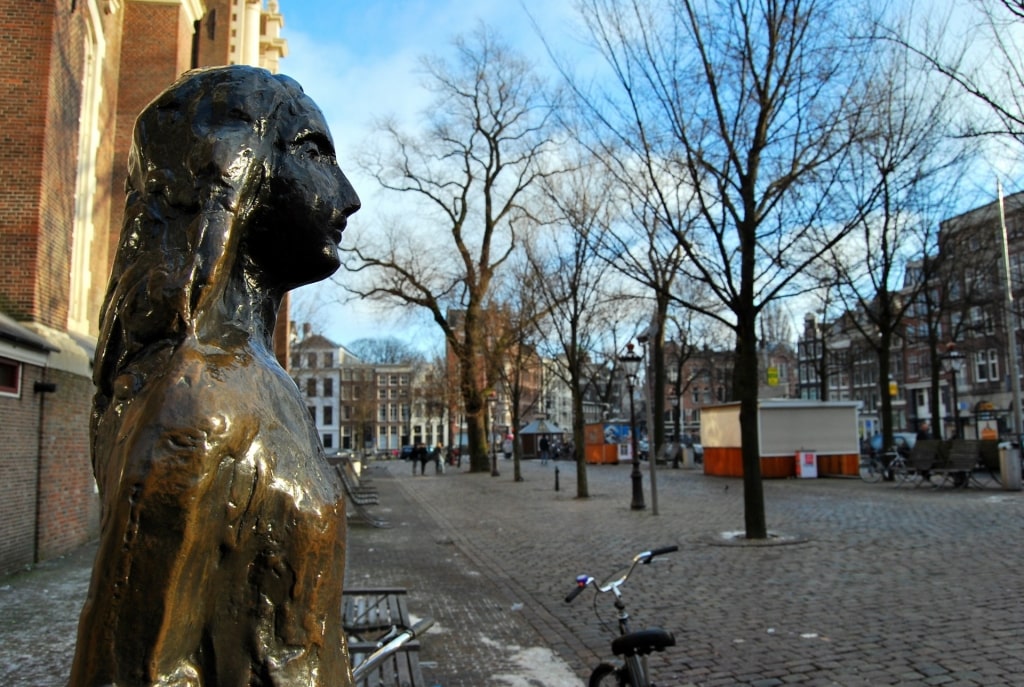
Anne Frank House
A visit to the Anne Frank House in Downtown Amsterdam is haunting, heartbreaking, and absolutely essential.
Anne Frank was one of more than 107,000 Jewish people in the Netherlands sent to concentration camps during World War II. Her story is both tragic and a testament to the resistance and resilience of the Dutch people during the war.
In 1942, at the age of just 13, Anne Frank went into hiding with her family to evade the Nazis in a “Secret Annexe.” For the next two years, the Franks lived in secrecy, utterly cut off from the outside world.
During that time, Anne recorded everything about her experience in a red diary, which was published posthumously. Millions of people around the world have since read The Diary of Anne Frank. Its pages reveal a thoughtful, funny, immensely brave adolescent whose voice continues to resonate to this day.
The Anne Frank House allows visitors to step back into her story and the narrow confines of her hiding space. It offers a window into the measures the Dutch Jewish people took to survive, as well as the lengths friends and neighbors went to hide them.
Note that since the Anne Frank House is one the most popular attractions in Amsterdam, advance tickets are highly recommended.
Learn All About Dutch Cheeses
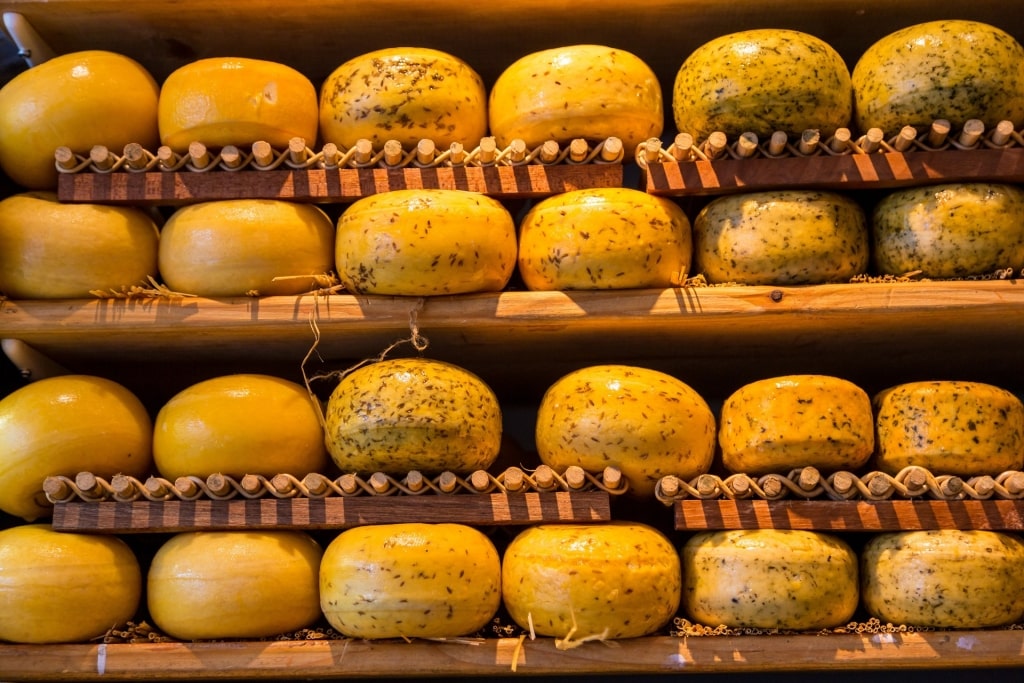
Amsterdam Cheese Museum
Despite its relatively small size, the Netherlands exports more than two billion pounds of cheese. That makes it the second largest exporter in the world—and that’s not counting the amount consumed at home. The average Dutch citizen eats roughly 37 pounds of cheese per year.
The Dutch love affair with dairy began in the Middle Ages, when cheese became so valuable they were accepted as fares for boats. The city of Haarlem held the nation’s first cheese market in 1266 and plenty of other Dutch cities have since followed suit.
Visitors to Amsterdam will quickly realize just why the Dutch are so fond of their Gouda, Boerenkaas, and Leerdammer. While much of the Dutch cheese sent abroad is mass-produced, the good stuff is really, really good.
Much of the Dutch dairy industry consists of small farms with humanely raised cows that graze freely on wild grasses. That makes for decidedly more delicious cheeses, sold here by the massive wheel.
The Amsterdam Cheese Museum on Prinsengracht is small, but very much worth a quick visit—for the free samples, if nothing else. There’s a quick crash course on the history of Dutch cheeses, plus the opportunity to snap a photo dressed as a cheesemaker. Most importantly, friendly staff are generous with slicing up Goudas to try.
Go Shopping at the Westerstraat Market
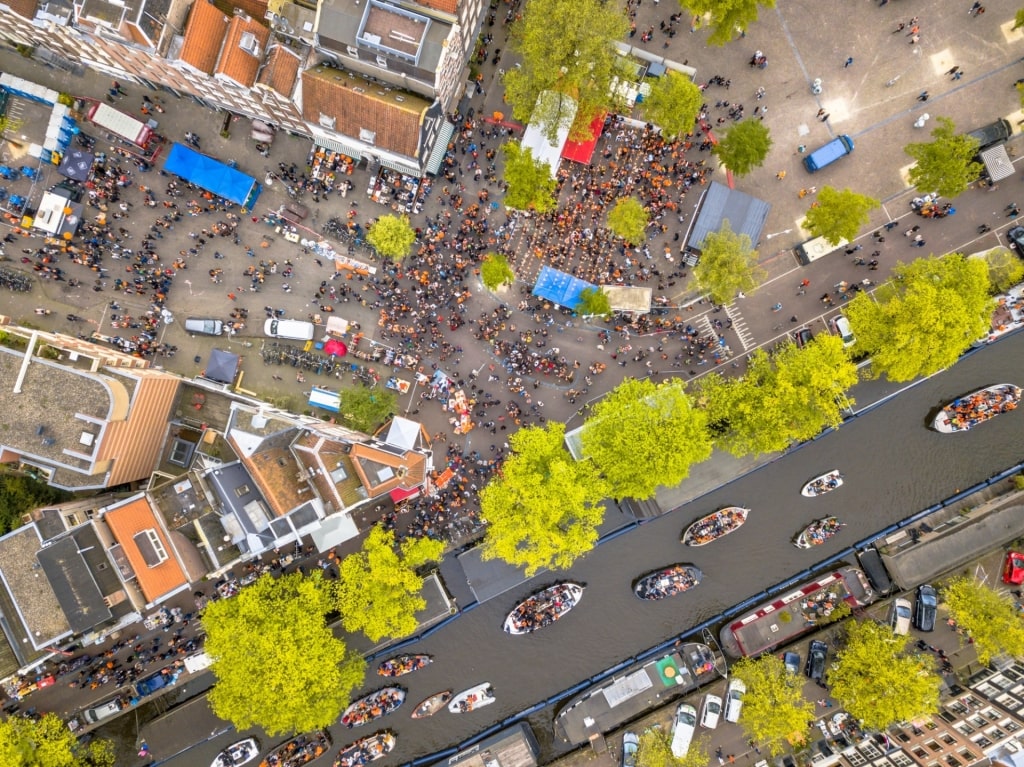
Westerstraat Market
This lively street market takes place in Jordaan every Monday. Sometimes called Westermarkt, this open-air market encompasses around 170 vendors. As with many flea markets, you can expect to find an eclectic mix of bric-a-brac, ranging from used books to children’s toys.
What makes the Westerstraat Market so special, though, is that this is paradise for lovers of vintage clothing. While plenty of textile markets traffic in knock-offs, the designer duds here are certified authentic.
If you’re willing to spend some time sorting through the piles, there are some stellar finds here, often at bargain basement prices. Think: Dolce & Gabbana, Versace, Chanel, Dior, and more big-name labels. These factory discards might have some minor, often unnoticeable defects, which can slash their price by a factor of 10 or more.
Cruise Along the Bloemgracht Canal
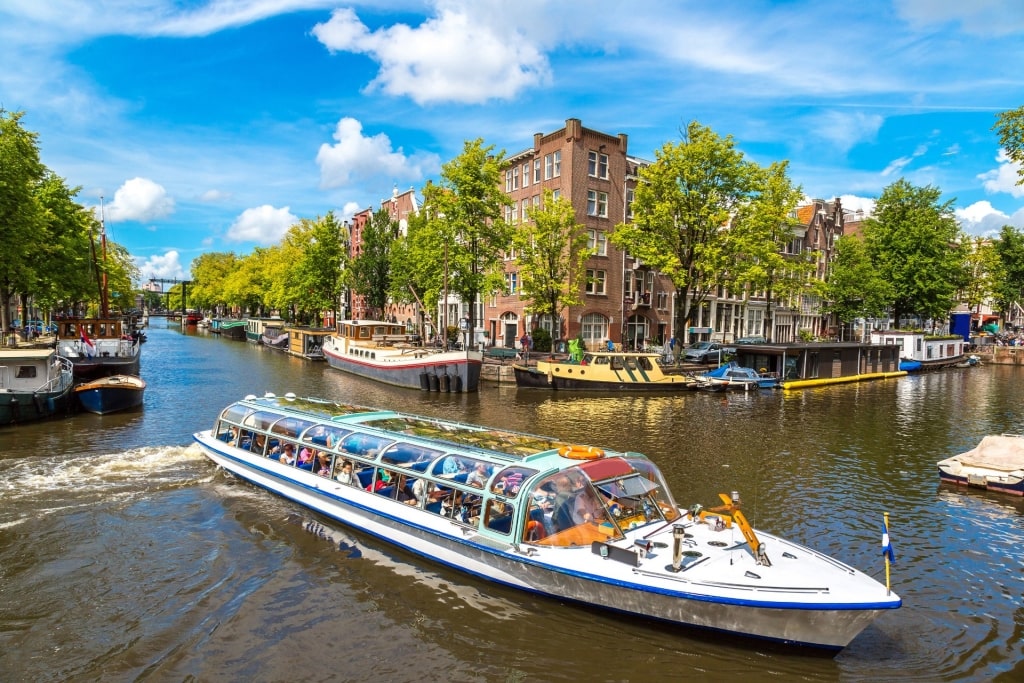
Canal in Amsterdam
By far the most fun way to experience Amsterdam is via its many waterways. The city’s 165 canals are a pleasure to navigate via a guided cruise.
Several of the UNESCO-lauded canals that run through the Jordaan neighborhood are particularly striking. Cruise your way through the Egelantiersgracht, Passeerdersgracht, Lauriergracht, Looiersgracht, and Bloemgracht.
Of the canals, the last one, which connects the Lijnbaansgracht and Prinsengracht, is especially charming. During the height of the Dutch Golden Age, Bloemgracht was considered one of the toniest addresses in town. As a result, the centuries-old canal houses that line it are especially ornate.
You could always appreciate the sights here on foot—or, as the Dutch do, via bicycle—but a canal cruise adds a lot to the experience. This area is especially packed with history, which a knowledgeable guide can help unveil. Painter Rembrandt van Rijn once had a studio here and the canal has been home to generations of noted Amsterdam luminaries.
Read: Best Things to Do in Amsterdam With Kids
Explore the Local Gallery Scene
Amsterdam is one of the best cities for art, and in the heart of Jordaan, the funky and vibrant Prinsengracht boasts an impressive number of art galleries.
Galerie Ron Mandos, a fixture in the local creative scene for more than two decades, hosts all sorts of talks, openings, and screenings.
Nearby, Stevenson Gallery tackles the complicated Dutch history of colonialism. The space focuses on exhibitions showcasing works from the African diaspora and South Africa. Keep an eye out for informative, thought-provoking talks with artists.
Practically around the corner on Bloemgracht, travelers will find one of the most significant galleries in Amsteram’s contemporary art scene. Galerie Fons Welters quite literally started in a garage more than three decades ago. It’s since developed a reputation for spotting and cultivating previously unknown artists.
Listen to Self-Playing Pianos
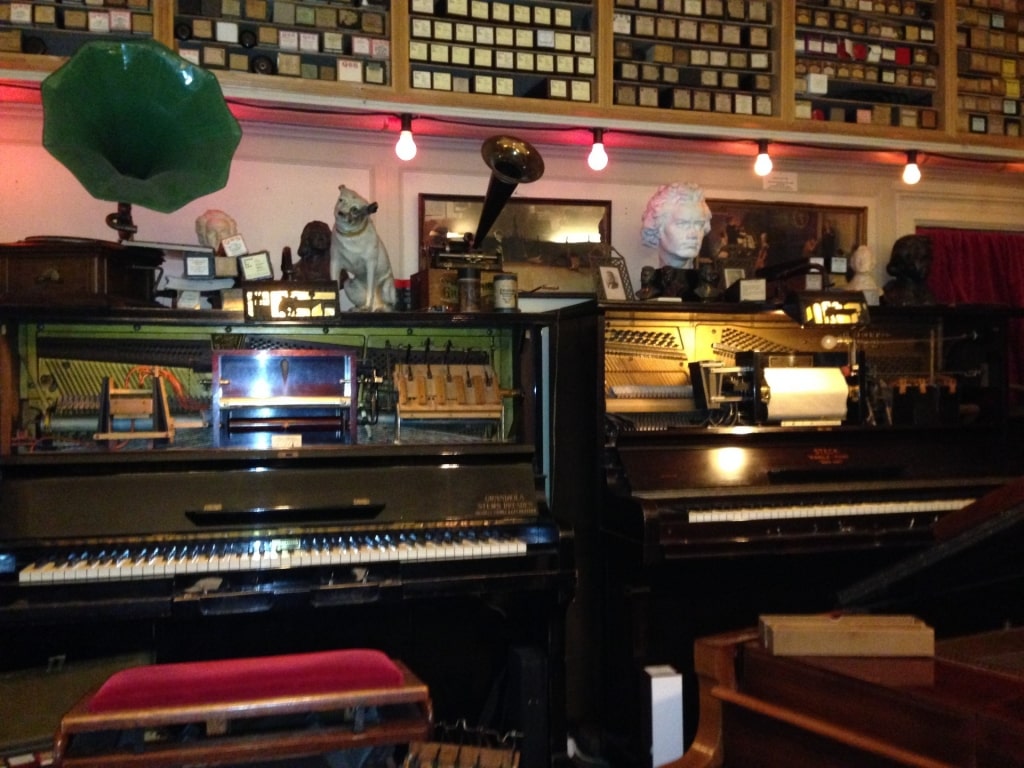
The Pianola Museum Photo by Ymnes on Wikimedia Commons, licensed under CC BY-SA 4.0
Around the first few decades of the 20th century, automated pianos were all the rage in fashionable homes. As recording technology improved, the craze gradually died off, to the extent that these contraptions are now something of a rarity.
In 1981, two avid piano collectors by the names of Theo de Boer and Kasper Janse founded the Dutch Piano Museum Foundation to showcase their instruments. Their efforts would later lead to The Pianola Museum, which has more than 30,000 rolls of music self-playing pianos.
The collection also includes rare pianofortes and other gems. As a bonus, the museum organizes regular concerts and musical performances.
Read: Best Art Museums in Amsterdam
Stop to Admire the Tulips
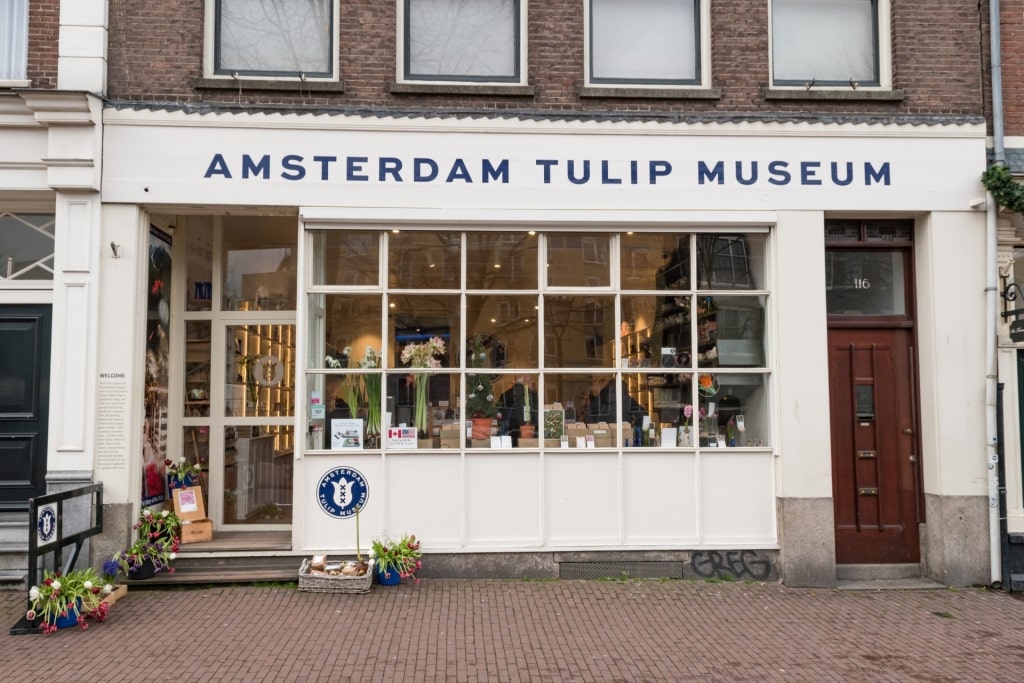
Amsterdam Tulip Museum Photo by dronepicr on Wikimedia Commons, licensed under CC BY 2.0
Tulips are incredibly close to the hearts and cultural identities of the Dutch. In the 1600s, these precious flowers were sometimes worth more than gold.
At the height of the so-called Tulipmania, investors would shell out the price of a mansion in Amsterdam for rare bulbs. Although the speculative flower market would eventually collapse, the Dutch love affair with tulips continues.
Today, the Netherlands exports roughly two billion tulips annually all over the world, far more than any other nation. In spring, the countryside erupts in wide swaths of color, a sight as synonymous with the nation as its windmills or wooden shoes.
Situated on the Prinsengracht Canal, the Amsterdam Tulip Museum dives into the fascinating history of these extraordinary blooms. The museum is small enough in size that visitors can get a crash course in tulips in roughly an hour.
Watch Live Musical Performances
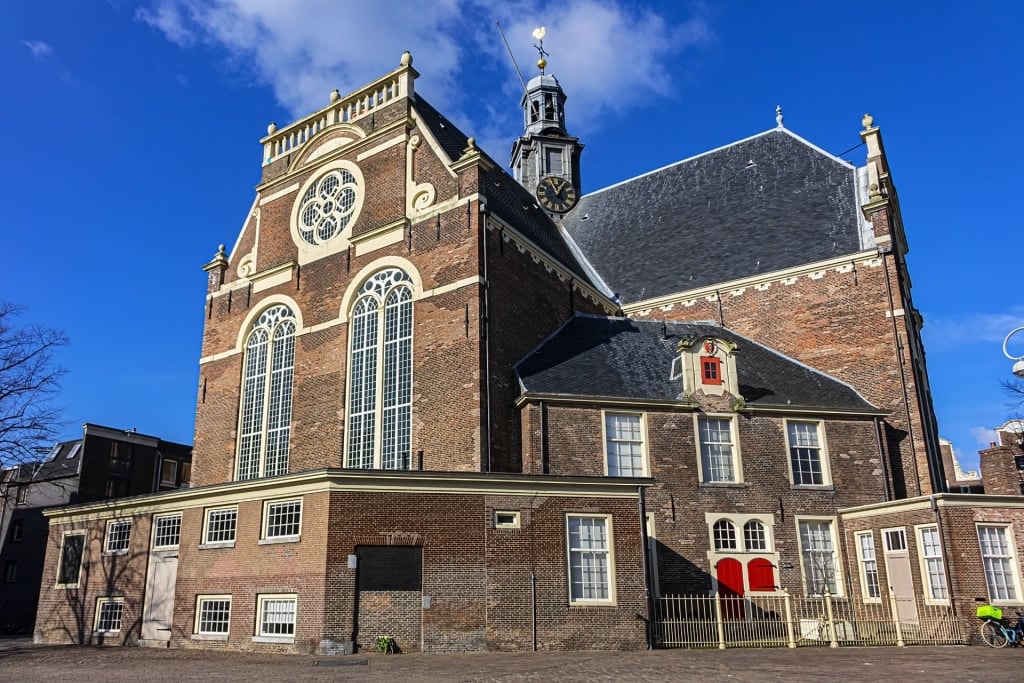
Noorderkerk
Built in the 1620s, the Noorderkerk is one of the most beautiful historic churches in Amsterdam. With its distinctive octagonal shape and high vaulted ceilings, it’s lovely to behold. This Protestant church is also known for its progressive attitudes and is welcoming to all.
Generations of Amsterdammers have come here to worship. Painter Vincent Van Gogh once very publicly expressed his admiration for the place.
Noorderkerk also happens to be one of the best places to see a live concert in this European capital city. On many Saturday afternoons, the Noorderkerk Concerts Foundation organizes incredible performances. Musical genres from opera to jazz are all represented here and building’s phenomenal acoustics elevate every artist’s work.
Feast on Pannenkoeken
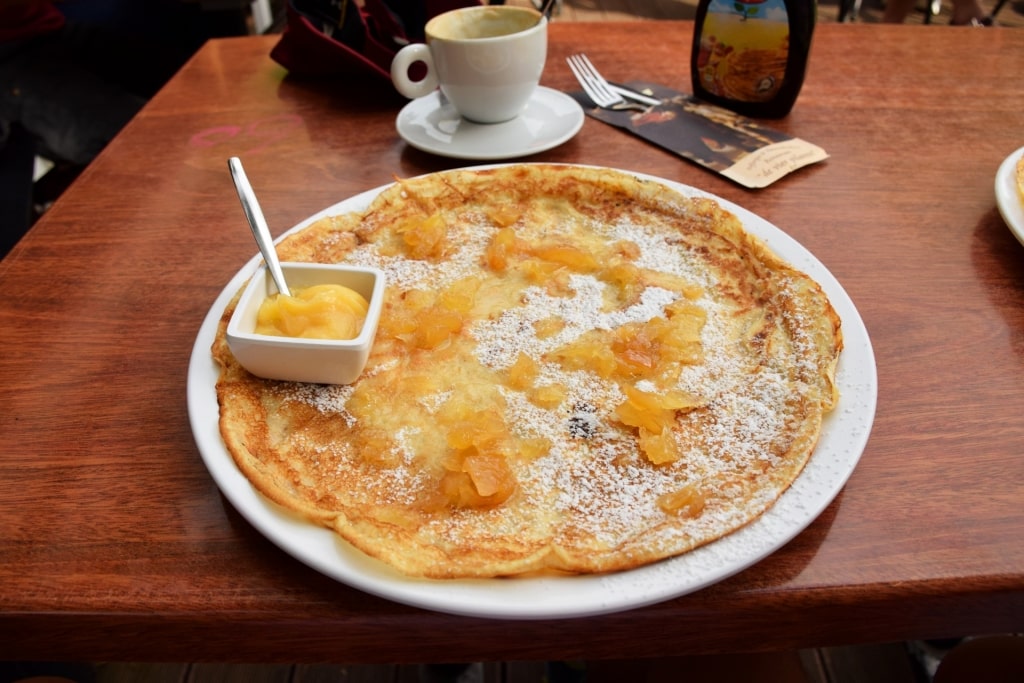
Pannenkoeken
Amsterdam is one of the best food cities in Europe, and if there’s one specialty that every visitor should try, it’s pannenkoeken, steering wheel-sized pancakes.
Thinner than their American cousins and ever so slightly thicker than a French crepe, pannenkoeken are equally perfect for breakfast, lunch, dinner, or dessert. Traditional toppings run the gamut from savory—most often ham and cheese—to sweet; apples and raisins, bananas and Nutella, or cinnamon-sugar.
While some restaurants stick to the classic flavors, others go gourmet with international additions ranging from Thai curry to brandied cherries.
There are a number of excellent places to get pannenkoeken around Jordaan. Eetcafé Roem is particularly lovely, especially if you manage to snag a seat on its canalside terrace.
Snap a Photo of the De Drie Hendricken
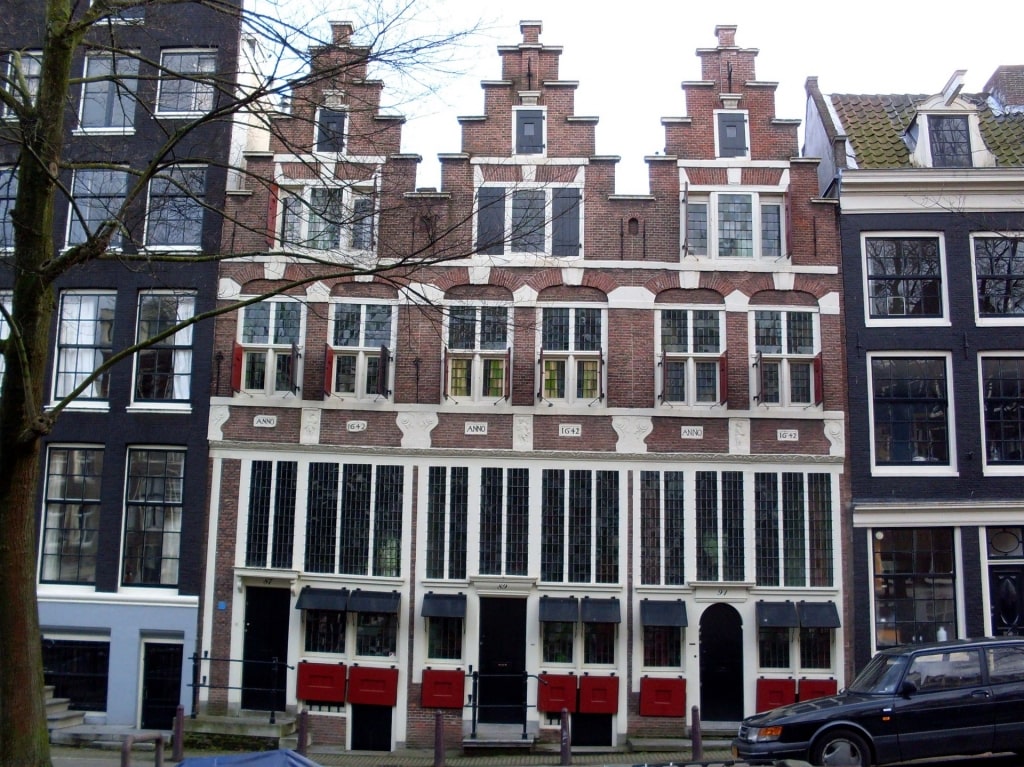
De Drie Hendricken Photo by Marcel mulder on Wikimedia Commons, licensed under CC BY-SA 3.0
It’s no secret that Amsterdam’s historic architecture makes it one of the most photogenic cities in all of Europe. Most of the distinctive tall, narrow canal houses date back to the 17th century when the Netherlands was at the height of its global power.
Unlike most other European powers of the time, the nation boasted a thriving, educated middle class with an entrepreneurial streak. The cleverly designed canal houses often served as homes, businesses, and storage spaces, making the absolute most of limited space.
De Drie Hendricken is an especially handsome, well-preserved canal house done up in the Renaissance style. Designed in 1642 by architect Hendrick Roelofsz, it’s one of the most beautiful buildings on the Bloemgracht Canal.
Pause for Coffee & Cake

Coffee
The Dutch take their afternoon coffee break seriously. Amsterdam is known for its coffee culture, meaning you can expect an excellent cup at almost any café.
And of course, the ritual wouldn’t be complete without something sweet to pair with it. The traditional accompaniment is a stroopwafel, or “syrup waffle.”
Comprised of two thin, chewy spiced cookies with a caramel center, a stroopwafel tastes best when warmed over a steaming cup until soft. While mass-produced stroopwafel can be found all over the world, bakers in Amsterdam produce wonderful artisanal versions.
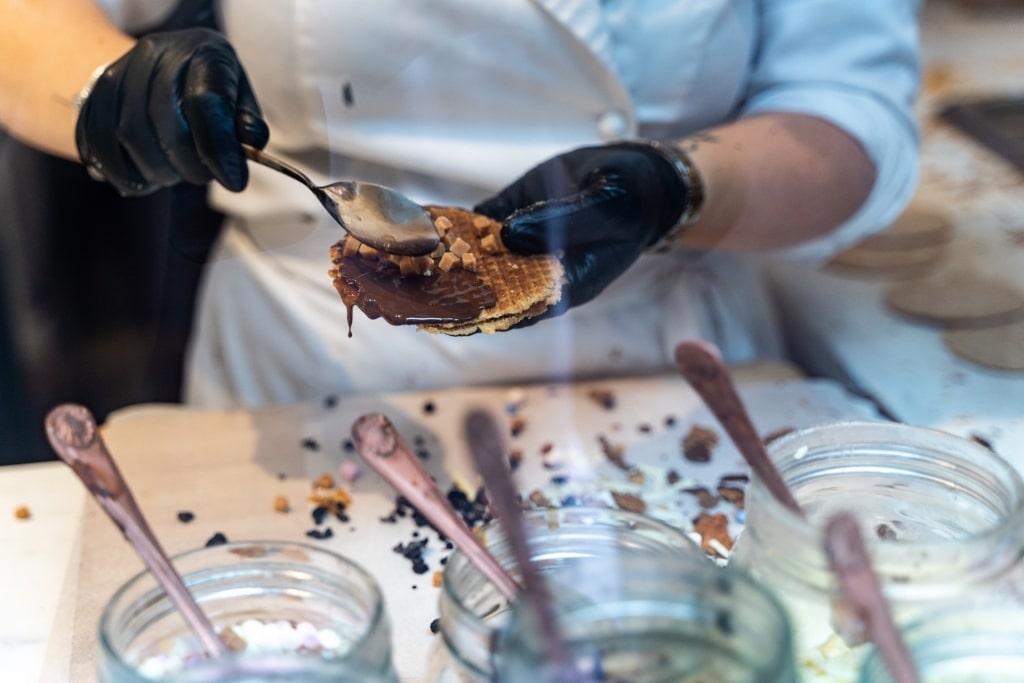
Stroopwafel
If you’re looking for more substantial food in Amsterdam, rest assured that the cafés here will have that too. Display cases tend to be full of towering, sugary delights. Of these, the crown jewel is inevitably the appel koek, or apple cake.
Dutch apple cake goes hard on the apples, with only a relatively small amount of batter binding them together. Perfumed with cinnamon and warm spices, it’s as comforting as desserts come.
Naturally, debate abounds as to who makes the best apple cake in Amsterdam. Many locals, however, swear by Winkel43, which has been baking for four decades. A popular tip when visiting Amsterdam is to check out this friendly eatery near Noordermarkt in Jordaan, where they serve their rendition with a tuft of whipped cream.
Visit a Real Houseboat
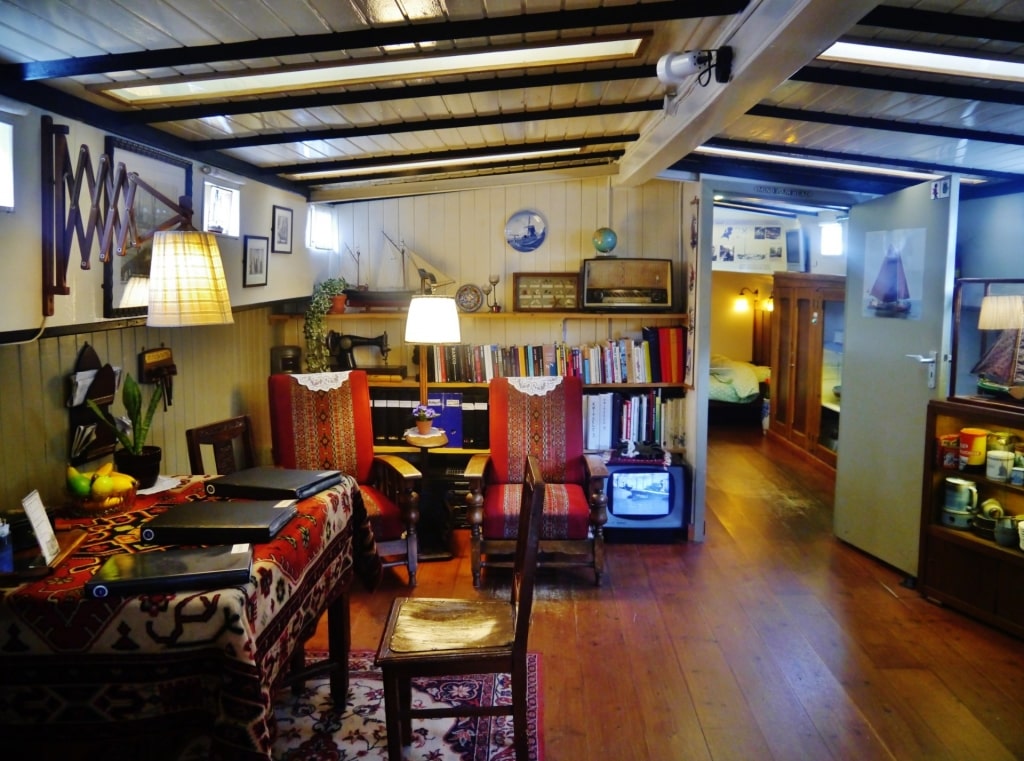
Houseboat Museum Photo by Zairon on Wikimedia Commons, licensed under CC BY-SA 4.0
Amsterdam’s canals are its lifeblood, but for some locals, they’re also quite literally home. More than 2,500 houseboats are moored along the banks of the canals.
Houseboats became popular after the end of the Second World War. With much of the city lying in rubble, there weren’t enough places on land for locals to live. Cheap, unfussy, and anti-bourgeoisie, these modest accommodations soon became popular with hippies.
Nowadays, some are used as short-term vacation rentals, but many still have full-time residents. Although the city no longer releases new houseboat permits, those who have a parking space are allowed to hang onto it.
One of the city’s quirkiest small museums offers a fascinating window into life on the water. The Houseboat Museum on Prinsengracht was actively used as a home up until 1997. These days, it welcomes visitors in 20 different languages. The interior has been preserved almost exactly the way it once was and makes for some great photo-ops.
Read: Three Days in Amsterdam
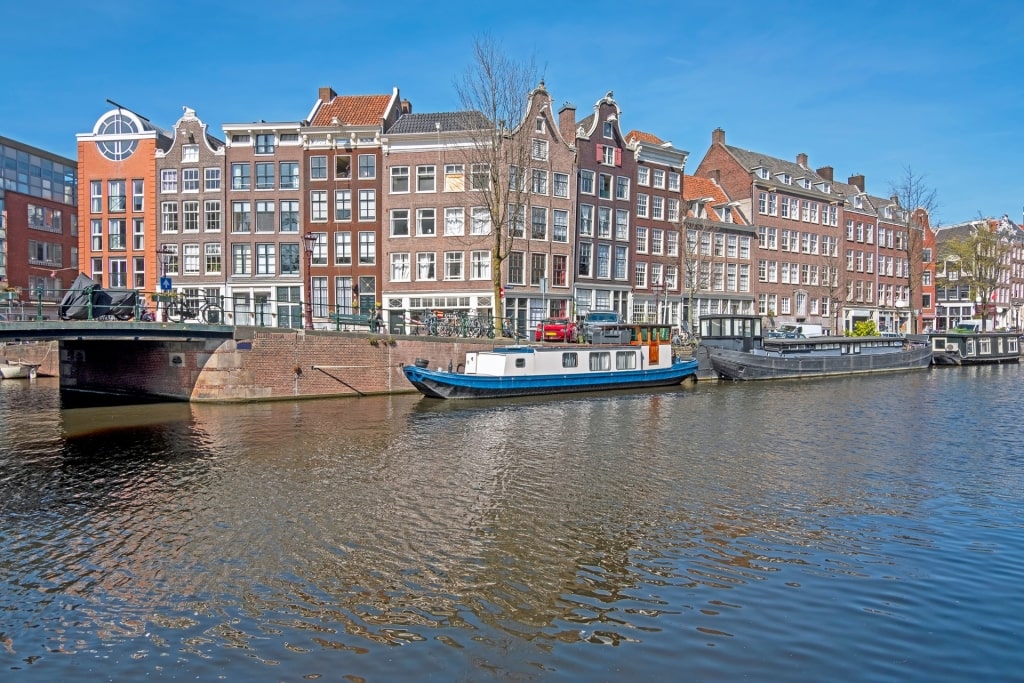
Jordaan
Experience the vibrant Jordaan neighborhood and all that Amsterdam has to offer on a cruise. Browse our cruises to Amsterdam and book your journey today.
